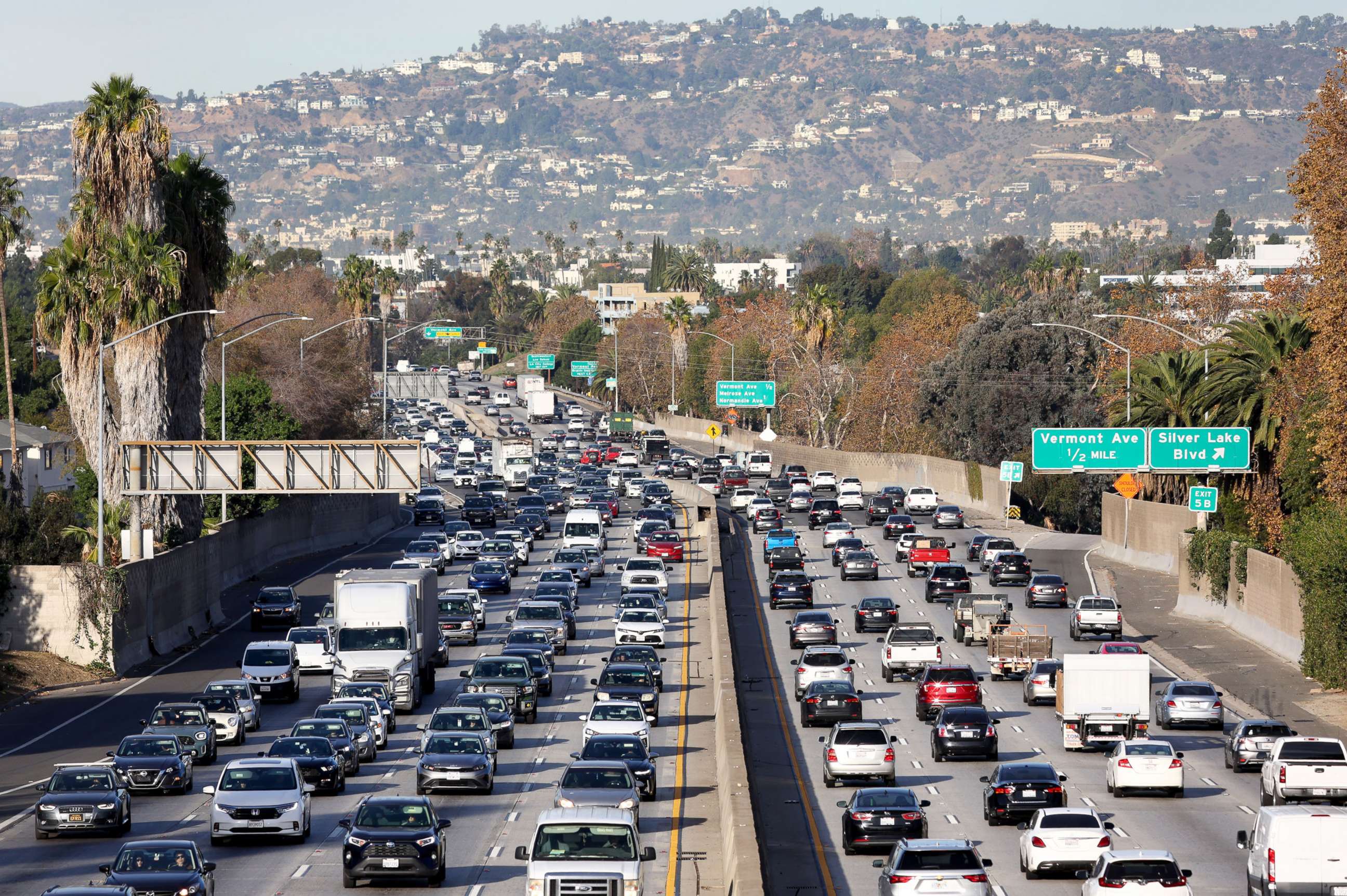Hidden ways the holidays harm the environment and how you can reduce the waste
The most festive time of the year is also the most wasteful, experts say.
The table is set. The decorations are up. The holidays are here, and it may be helpful to know how all that holiday cheer is affecting the environment and greenhouse gas emissions being released into the atmosphere.
Household waste increases by more than 25% from Thanksgiving to New Year’s, according to Stanford University's Waste Reduction, Recycling, Composting and Solid Waste Program. The additional waste -- in the form of food, shopping bags, packaging, wrapping paper, bows and ribbons -- contributes to an additional 1 million tons of trash entering landfills each week during that time frame, the report said.
Research shows that consumers are prioritizing sustainability when deciding what to spend their money on.
A 2021 survey by the IBM Institute for Business Value found that 93% of global respondents changed their views on sustainability as a result of a pandemic, and more than half of global respondents in a survey conducted in February of this year found that environmental sustainability is more important to them today than it was a year prior.
Consumers spending habits are beginning to match their intent. Half of the consumers polled in 2021 said they were willing to pay a premium for a sustainable brand or sustainable products, according to IBM.
But, people can still enjoy the magic and wonder of the holidays while staying informed to weigh their consumer decisions better, Kate White, senior associate dean of equity, diversity, inclusion and sustainability at the University of British Columbia's Sauder School of Business, told ABC News.
"All of this isn't really to make people feel guilty, but maybe make people just consider different options," she said.

Here are some of the ways the holidays affect the environment:
Gifts
The "stuff" consumers purchase during the holidays, namely, gifts, is where the majority of the waste comes from, White said. This is especially problematic considering how many gifts people receive that they do not like or have no intention of using.
"Maybe some of them are not necessarily wanted," White said. "And so a lot of stuff ends up in the landfill. So thinking about how we can reduce the stuff is probably a big one."
Stanford University suggested gifting durable and reusable items and resisting the latest "fad" at the mall, such as pet rocks, mood rings, and cabbage patch dolls.
Gifts that carry a message of conservation and environmentalism could also be beneficial, according to the university, such as a nature book, refillable thermos bottle, canvas tote bag, battery recharger or items made from recycled materials. In addition, solar-powered gifts, instead of battery-powered products, or gifts that require no power at all, should also be considered.
Other sustainable gifts can be donations to meaningful charities, homemade -- such as baked goods, knitted items and ornaments -- or experiences, such as movies, spa days or other activities, White said.
The process of returning gifts is also environmentally unfriendly. The shipping process for returns emits around 16 million metric tons of carbon dioxide a year, and e-commerce returns produce 14% more waste than in-store ones, according to research conducted in 2020 by the Environmental Capital Group. About 5.8 billion pounds of returned inventory ends up in landfills every year, according to the report.
The materials used to wrap the gifts also have an immense impact on the environment.
About 8,000 tons of wrapping paper, the equivalent of about 50,000 trees, is used to wrap gifts each year, according to the Clean Air Partnership, a nonprofit environmental organization.
Gift-givers and receivers can also recycle wrapping paper. One ton of recycled wrapping paper is equivalent to the energy of 185 gallons of gasoline, the nonprofit said.
About 2.65 billion holiday cards are sold each year in the U.S. -- that amount could fill a football field 10 stories high, according to Stanford.
The Clean Air Partnership suggested that gift-givers and receivers recycle wrapping paper to reduce waste. If every American family wrapped just three presents in reused materials, such as a magazine or comic book pages, old maps or brown paper bags, it would save enough paper to cover 45,000 football fields, according to Stanford.
White also recommended wrapping gifts in materials that can be reused, such as a tea towel, bandana, or jar or container they can use again.
The nonprofit also suggested sending e-cards or using recycled cards instead of traditional holiday cards made with glossy paper and glitter. Stanford said that serious recyclers can also save the front of the cards they receive every year and send them out as "postcards" for future holidays.

Decorations
Holiday decorations are also some of the most wasteful.
More than 25 million to 30 million Christmas trees are sold in the U.S. every year, according to the National Christmas Tree Association.
And while plastic Christmas trees may be appealing for those looking to reuse them year after year, the materials they are made from may not make them a better option.
A 2009 study by Ellipsos, a Canadian sustainable development consulting firm, found that plastic Christmas trees contain PVC, a toxic carcinogen that is difficult to dispose.
The problem is, once the trees are disposed of, the plastic will likely take thousands of years to break down, while Christmas tree farms absorb carbon dioxide from the atmosphere and release clean oxygen back in, according to the National Christmas Tree Association.
The best option is to find a Christmas tree farm that rents potted trees and then re-plants them at the end of the season, White said. But if a plastic Christmas tree works better for your needs, White suggested keeping it for at least five to 10 years.
White suggested finding a holiday tree composting program once the real trees have dried, most of which turn the trees into mulch to be used around local green spaces.
The millions of additional twinkling lights can also be an environmental detriment. White cautioned against leaving lights -- both those in outdoor settings and those on the Christmas tree -- on all day and night, despite how pretty they may be.
Families can reduce the energy consumption from Christmas lights by switching to LED lights, which use up to 95% less electricity than traditional lights, according to the Clean Air Partnership.
Holiday enthusiasts can also choose natural, biodegradable decorations, such as cranberries, popcorn, live flowers and greenery, according to the nonprofit.

Travel
Transportation is the No. 1 source of carbon dioxide emissions associated with the holidays, White said. More than half of Americans planned to travel during the 2022 holiday season, according to PricewaterhouseCoopers's annual Holiday Outlook, released in October. This is a massive uptick from the 33% of people who planned to travel for the holidays in 2019, prior to the pandemic, according to PWC.
People concerned about their carbon footprint should consider which method of transportation best suits their needs and releases the least emissions.
Driving is less impactful than air travel, while bus and train travel is less impactful than driving, White said.
White suggested limiting driving as much as possible during the holidays, urging people to "stack" their visits to places that may be further away.
"If you're going to go visit one family or one set of friends, go visit everyone on the same trip," she said. "Don't make three or four trips."
If each family in the U.S. reduced gas consumption by 1 gallon, or opted to drive 20 miles less, it could lead to 1 million tons of reduced greenhouse gas emissions, according to the Clean Air Partnership.

Food
The other biggest driver of an increase in CO2 emissions during the holidays is the increase in food consumption,
Food typically travels about 1,500 miles from farm to plate, on average, according to the Clean Air Partnership, which suggested that holiday hosts serve organic or locally grown foods and prepare only as much food as needed.
White suggested that consumers consider how far away the food is coming from and what is being served to reduce emissions. Beef has, by far, the highest carbon footprint, followed by poultry, fish and vegetarian meals, she said.
Americans waste between 30% and 40% of the food supply each year, but that amount increases by 25% during the holidays, according to the U.S. Department of Agriculture.
Any uneaten food that has spoiled should be composted, according to Stanford University.
Waste can also be eliminated by utilizing reusable glassware, flatware, dishware table coverings and napkins for holiday meals. Hosts should provide containers for recycling aluminum and glass beverage bottles and cans, according to the Clean Air Partnership.




